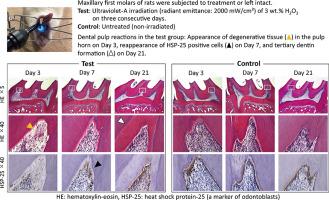Journal of Photochemistry and Photobiology B: Biology ( IF 3.9 ) Pub Date : 2020-09-24 , DOI: 10.1016/j.jphotobiol.2020.112042 Keisuke Nakamura , Midori Shirato , Shunichi Shishido , Yoshimi Niwano , Taro Kanno , Keiichi Sasaki , Peter Lingström , Ulf Örtengren

|
Hydrogen peroxide photolysis-based antimicrobial chemotherapy that utilizes ultraviolet-A irradiation (UVA-H2O2 photolysis) has been previously proposed as a method of treatment of cariogenic biofilm. Therefore, in the present study, we aimed to assess time-dependent reactions in the dental pulp of rats after UVA-H2O2 photolysis. Maxillary first molars were treated. UVA irradiation (wavelength: 365 nm) with 3 wt% H2O2 was performed for 90 s at a radiant emittance of 500–2000 mW/cm2 on the rats for 3 consecutive days or only 1 day. The animals were sacrificed at Days 1, 3, 7, and 21 after the treatment for the histological evaluation of inflammatory cells and immunohistochemistry of heat shock protein (HSP)-25, a marker of odontoblasts. Tertiary dentin formation was evaluated at Day 21 by histomorphometry and micro-CT analysis. UVA-H2O2 photolysis elicited little infiltration of inflammatory cells, but disturbances in the odontoblast layer and/or presence of localized degenerative tissue were observed on Day 3. This condition was followed by a healing process that was characterized by the reappearance of HSP-25 positive odontoblast-like cells at Day 7 and tertiary dentin formation at Day 21. The amount of tertiary dentin formed was dependent on the intensity of treatment; repeated UVA irradiations of H2O2 at 2000 mW/cm2 resulted in the largest amount of tertiary dentin formation at the pulp horn regions. Our findings suggest that UVA-H2O2 photolysis treatment can be used to treat dental caries clinically because the post-treatment inflammatory reaction was minimal and tertiary dentin formation was substantial, which may prove effective in protecting dental pulp from external irritants. As a cautionary consideration, the radiant emittance of the UVA irradiation should be carefully optimized before clinical application.
中文翻译:

紫外线-A照射下牙髓对过氧化氢光解抗菌药物的反应
先前已经提出了利用紫外线-A辐射的过氧化氢基于光解的抗微生物化学疗法(UVA-H 2 O 2光解)作为致癌生物膜的治疗方法。因此,在本研究中,我们旨在评估UVA-H 2 O 2光解后大鼠牙髓中的时间依赖性反应。治疗上颌第一磨牙。用3 wt%H 2 O 2进行UVA辐射(波长:365 nm),辐射时间为500–2000 mW / cm 2,持续90 s。在大鼠上连续3天或仅1天。在处理后第1、3、7和21天处死动物,用于炎性细胞的组织学评估和成牙细胞标记的热休克蛋白(HSP)-25的免疫组织化学。在第21天通过组织形态计量学和显微CT分析评估叔牙本质的形成。UVA-H 2 O 2光解引起炎症细胞的浸润很少,但是在第3天观察到成牙本质细胞层的紊乱和/或局部变性组织的存在。这种情况之后是一个愈合过程,其特征是HSP-25阳性成牙本质细胞样的重新出现在第7天时形成细胞,在第21天时形成叔牙本质。形成的叔牙本质的数量取决于治疗的强度。在2000 mW / cm 2的H 2 O 2的重复UVA照射下,在纸浆角区域形成最大量的叔牙本质。我们的发现表明,UVA-H 2 O 2光解治疗可用于临床治疗龋齿,因为治疗后的炎症反应极少,并且叔牙本质的形成非常明显,这可能被证明可以有效地保护牙髓免受外部刺激。出于谨慎考虑,在临床应用之前应仔细优化UVA辐射的辐射发射率。











































 京公网安备 11010802027423号
京公网安备 11010802027423号